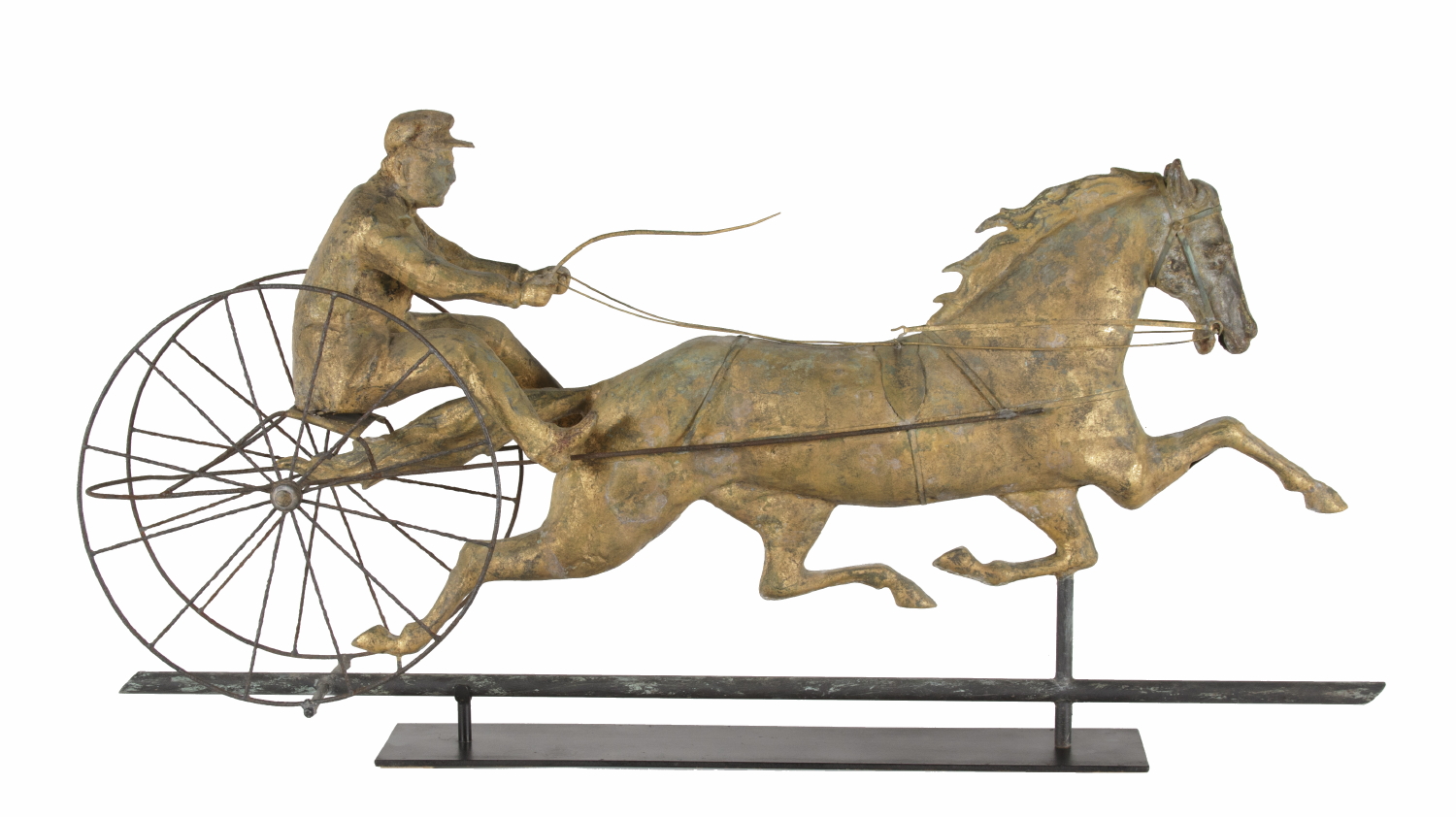
| |
THE HORSE GEORGE M. PATCHEN WITH A SULKEY AND DRIVER, ONE OF THE LARGEST AND MOST IMPRESSIVE AMONG THIS FORM OF WEATHERVANE, UNIDENTIFIED MAKER, ca 1860-1890's |
| |
|
| Dimensions (inches): |
25" tall x 48" long x 9" wide |
| Description: |
|
This is the horse George M. Patchen with a sulky and driver. Made of hammered copper with iron wire wheels, frame and whip, and reins made of copper sheeting, the likeness is truly full-bodied and the scale is especially large and impressive. Patchen was an early participant in the world of American harness racing and his likeness was produced for many years by numerous makers. He was a Morgan Horse, sired by the horse Cassius M. Clay. Foaled in 1849, he was bred by Richard F. Carman of Monmouth County, NJ. He was bay, approximately 16 hands and very successful on the racetrack winning 20 races with a time of 2:23 1/2. He died in 1864, but his popularity carried throughout the latter 19th century and the form was still available until after 1900.
Illustrations in the catalogues of weathervane manufacturers probably did not always represent the actual vane precisely. That said, a very accurate depiction of Patchen in this particular style is represented by the illustrations of no less than 4 makers, including Thomas W. Jones of New York (1882 catalogue, p. 7), L.W. Cushing & Sons of Boston (1883 catalogue, p. 8), William Buck of Philadelphia (1892 catalogue, p. 5), and W.A. Snow Iron Works of Boston (1904 catalogue, p. 7). These illustrations are nearly identical to one-another and accurate to the position of the all features, including the angle and shape of the head, mane, and tail. Head position while running is a key identifier in race horses in general and particularly so in 19th century weathervanes, most of which were copied from Currier & Ives prints.
The hat worn by the driver in a famous Currier and Ives illustration of a race between George M. Patchen and Ethan Allen, clearly illustrates the one worn here by Patchen's driver, who sits back fairly far from the rear of the horse--a trait not generally shared by the drivers in other large horse and sulky weathervanes, that sit much closer to the base of the tail. As for the horses, Ethan Allen is a very similar horse in weathervane form, as is Mountain Boy, but the head on George M. Patchen is typically tipped further downward, as it appears in this instance in both the weathervane and Currier's illustration. A horse named Dexter has an even further downward tilt. All of these traits come from Currier & Ives depictions.
This exact horse is illustrated with a four-wheel sulky or surry (often inaccurately called a wagon by weathervane manufacturers) in "The Art of the Weathervane" by Steve Miller (1984, Schiffer Publishing, Exton, PA), on page 32. Miller identifies the manufacturer as Mott Iron Works of New York and Chicago. Since only perhaps 1 in 100 weathervanes were signed, the attribution is probably educated guesswork. My research does not support this attribution, because according to Mott's catalogue, its version of Patchen has a different head and the mane and tail don't match. In addition, this driver doesn't appear to match any of Mott's. But in all fairness to Miller, the illustrations, once again, were probably not always precise. Also, a sulky with the driver that appears with this Patchen is illustrated by Miller on page 34. Miller makes no attribution of this vane to Mott, but Mott just so happens to have offered a horse by the name of Maud S. with sulky and driver that accurately matches the one on page 34 by Miller. So it is possible that this is a Mott vane using the same driver, with Patchen instead of Maud, and with the driver in the appropriate position, further back.br />
Thomas Jones of New York offered Patchen in their 1882 catalogue with both two-wheeled and four-wheel sulkies, but the driver shown in their illustrations wears a rounded hat. Harris & Company of Boston is the only weathervane manufacturer to offer Patchen and Sulky with a driver that wears this square hat, but the position and pose of the driver is inaccurate, as-is their version of Patchen.
In summary, not enough information is known to absolutely nail down the maker, but Patchen with a sulky and driver is very rare among the huge vanes in this form, which makes this a great find. I am not aware of any other examples of this exact style that have survived.
Condition: The gilded and verdigris surface only partially original. It is the form that substantiates the price. The body and hat of the rider were bent significantly inward. There were minor seam separations and the whip was absent. A new whip was made, the seams re-soldered, and the dents removed. The necessary affected areas were re-surfaced accordingly, painted to match. The repair work was performed by John Halleck in Connecticut. |
|
|
| |
|
| Primary Color: |
gold, green |
|
| Earliest Date: |
1870 |
|
| Latest Date: |
1890 |
|
| For Sale Status: |
Sold |
|
| Price |
SOLD |
|
| E-mail: |
info@jeffbridgman.com |
|
 |
|
Page Views:... 893 |
|


